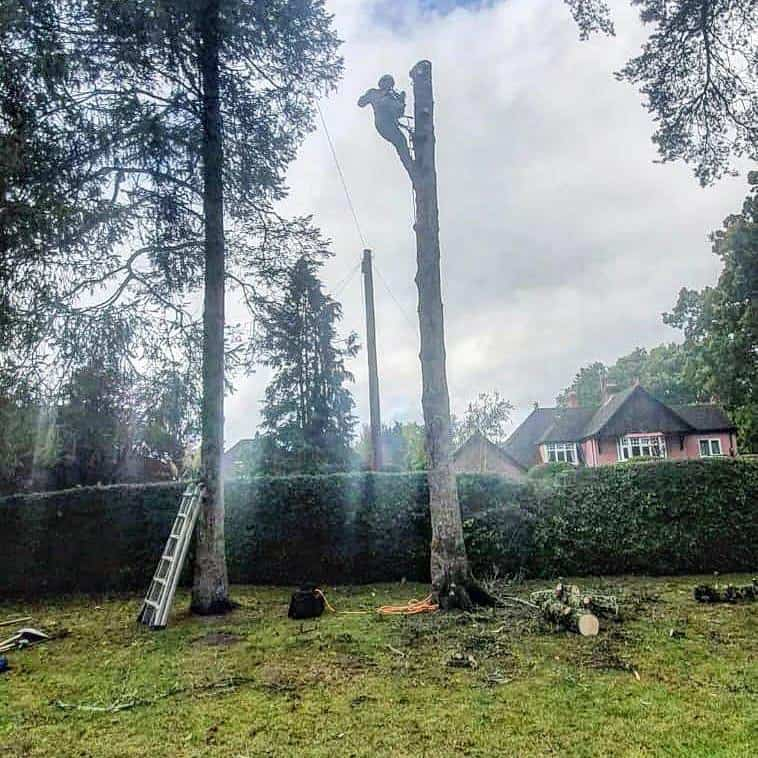Mature trees are not only an integral part of our landscape but also contribute to the overall health of the environment. However, as trees age, homeowners often face the challenging decision of whether to fell or preserve them. At LM Tree Surgery Petersfield, we understand the importance of assessing the condition and life span of mature trees to make informed decisions that benefit both the tree and the surrounding property. In this article, we’ll explore the factors to consider when deciding whether to fell or save a mature tree in Petersfield, Hampshire.
Signs of a Healthy Mature Tree
Before making any decisions about a mature tree, it’s essential to assess its current health. Healthy mature trees can thrive for decades or even centuries, contributing beauty and shade to your property. Some signs of a healthy tree include:
- Strong, Sturdy Branches: Healthy trees will have firm, well-attached branches with no significant dieback or decay. Branches should have a full set of leaves during the growing season, without signs of disease.
- Stable Trunk Structure: The trunk of a healthy tree should be free from cracks, cavities, or significant damage. Additionally, there should be no signs of fungal growth or excessive leaning, which may indicate internal weakness.
- Vibrant Foliage: A tree with consistent, vibrant leaves each year is generally in good health. Discolouration, sparse foliage, or premature leaf drop can indicate underlying health issues that need further investigation.
If your mature tree exhibits these signs of health, there’s no immediate reason to consider felling. Regular maintenance, such as pruning and deadwood removal, can help ensure its longevity.
Warning Signs That a Tree May Need to Be Felled
Unfortunately, some trees may suffer from structural problems, disease, or environmental stressors that compromise their stability and health. Felling may be necessary to prevent potential hazards. Here are key warning signs that a tree might be nearing the end of its life span:
- Root Damage: Damage to the root system is often difficult to spot, but it can have a significant impact on the stability of the tree. Roots can become damaged due to construction, soil compaction, or disease. Signs of root damage may include sudden leaning or poor growth in the upper canopy.
- Dead or Dying Branches: While occasional dead branches are normal, an excess of dead or dying limbs indicates a decline in the tree’s health. If the tree has several large, dead branches, it may be nearing the end of its life span.
- Fungal Growth: Fungi growing at the base of the tree or along the trunk often indicates decay inside the tree. Fungal growth, such as mushrooms or conks, is a sign that the tree is deteriorating from within, which compromises its structural integrity.
- Severe Trunk Damage: Cracks, splits, or cavities in the trunk can weaken a tree’s ability to stand upright, especially during storms. Significant trunk damage may leave the tree vulnerable to collapse, posing a risk to nearby structures or people.
If your mature tree shows any of these signs, it’s crucial to have a professional assessment by a qualified tree surgeon. At LM Tree Surgery Petersfield, we offer expert advice to help you determine whether felling is the safest and most responsible course of action.
When to Consider Tree Preservation
Not all trees that exhibit signs of age or damage need to be felled. In many cases, mature trees can be saved with the right care and intervention. Preservation efforts may be worth considering in the following scenarios:
- Tree Stability Can Be Restored: If a tree has suffered damage to a few branches or has limited decay, it may still be salvageable with pruning, bracing, or other corrective measures. A professional tree surgeon can provide a thorough assessment and recommend appropriate treatments to extend the life of the tree.
- Historical or Environmental Value: Some trees have significant historical, ecological, or aesthetic value. Preserving these trees may be a priority for homeowners, local communities, or conservation efforts. In such cases, working with a tree surgeon who specialises in preservation is essential to ensure the tree remains healthy and safe.
- Limited Risk to Property: If a tree poses no immediate danger to property or people and is not in immediate decline, monitoring its health may be the best course of action. Regular inspections and maintenance can help manage potential risks while preserving the tree’s benefits.
The Importance of Professional Assessment
When faced with the decision of whether to fell or save a mature tree, seeking a professional assessment is essential. Tree surgeons have the experience and knowledge to evaluate the structural integrity and health of a tree, providing homeowners with informed recommendations based on the latest arboricultural practices.
At LM Tree Surgery Petersfield, we take a careful, considered approach to each tree we assess. Our goal is to prioritise the safety of your property while also ensuring that valuable mature trees are preserved whenever possible. We provide thorough inspections, expert advice, and tailored solutions to meet your tree care needs.
Conclusion
Deciding whether to fell or save a mature tree is a complex decision that requires careful assessment of the tree’s health, structural integrity, and potential risks. By understanding the warning signs of decline and seeking professional guidance, you can make the right choice for your property and the environment. At LM Tree Surgery Petersfield, we offer expert tree surgery services to help homeowners in Petersfield, Hampshire, maintain the safety and beauty of their trees. Contact us today for professional tree assessments and care tailored to your needs.
Call us on: 01730 771 391
Click here to find out more about LM Tree Surgery Petersfield
Click here to complete our contact form and see how we can help with your tree’s needs.

